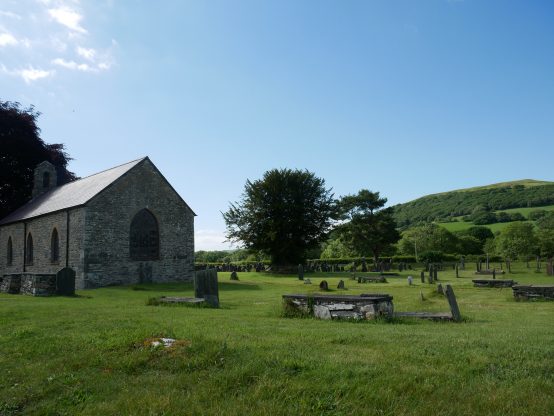by The Curious Scribbler
There is a celebrated yew at Strata Florida. It is certainly old, and by tradition is deemed to be the yew under which the fourteenth century poet Dafydd ap Gwilym is buried. Its status was marked by a painted stone bearing his dates which lay in the undergrowth at its foot, and was then further established with an inscribed slab installed by the Honorable Society of Cymmrodorion in 1951. To further advertising the poet they at the same time installed an even larger inscribed slab within the adjoining abbey ruins. Walking through the footings of the north transept one cannot miss the huge commemorative slate rectangle, like an outsized gravestone, officiously engraved in Welsh and Latin, which is affixed to the wall by iron cramps.
Current scholarship is a little less emphatic. The excellent little book, The Poetry of Strata Florida, by Dafydd Johnston examines the evidence and exposes the assertion to a measure of doubt. The antiquary John Leland writing in 1540 stated that there were 39 vast yews in the cemetery, while by 1874 there were only three. Statistically, Dafydd ap Gwilym could have been under any one of these trees!
Johnston further points out that he may not be buried there at all. A substantial strand of evidence for the grave under the tree has been a poem by ap Gwilym’s contemporary poet Gruffud Gryg. The poem is addressed to the yew tree above Dafydd ap Gwilym’s grave. However I now learn that writing marwnadau ffug – mock elegies – was a popular pastime for fourteenth century poets. There are several known instances of pairs of poets writing reciprocal elegies for one another – obviously at least one in each of these pairs must have been alive at the time, and possibly both were. These elegies were complimentary, as were the praise poems which poets composed about the homes of the the princes and landowners they visited.
Dafydd ap Gwilym was a native of Llanbadarn Fawr and may have learnt to write at the abbey scriptorium. He was not just a professional sycophant turning out eulogies about broad acres, fat cows, and fine houses. Much of his work celebrates nature, love and indeed lust. He sounds like a cheerful chap, addressing his love poems to Dyddgu or Morfudd or indeed improper suggestions to the Cistercian nuns of Llanllugan in Montgomeryshire. He depicts woodland as a church and bird as clergy, or holly as a lover’s bower.
So irrespective of the exact truth it seems very apposite that he should have a tree as his memorial. When I visited it today, the silence of this deeply rural spot was only broken by a party of screaming swifts flying low over the ruins and the intermittent clamour of baby birds from the top of the yew. I discovered that pair of kestrels have chosen to rear their nestlings in the top of Dafydd ap Gwilym’s tree. This is surprising, for kestrels barely build a nest and typically nest in crags or old buildings. Perhaps an old crow’s nest has provided a sufficient platform for their eggs. I feel sure Dafydd ap Gwilym would have approved.

St Mary’s church Strata Florida and Dafydd ap Gwilym’s yew
An alternative stratagem for remembrance is represented by the huge black marble memorial situated between the church and the abbey wall. Sir David and Lady Grace James died in the 1967 and 1965 respectively. His business interests had expanded from his father’s London dairy business to foodstuffs and cinemas. He acquired a country estate, Sutton Hall, Barcombe, and a knighthood. His roots were at Pantyfedwen and the couple were justly proud of their wealth and their worth as philanthropists and patrons of Welsh culture. Bold capitals on six faces of the column assert their names, their charitable trusts, their characters and their claims to fame in considerable detail. Will this massive memorial outlast the reputation of the poet, or vice versa?

The memorial to Sir David and Lady Grace James.




